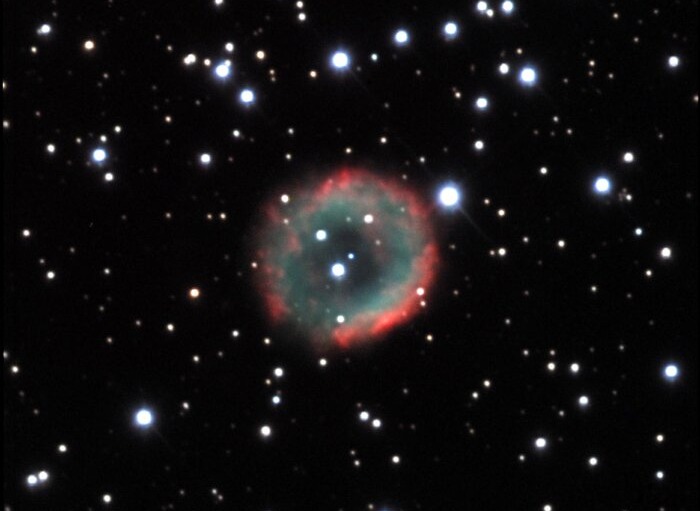NGC 2438 is a planetary nebula located in the southern constellation of Puppis. Discovered by the German-born British astronomer William Herschel in 1786, this nebula has become an intriguing subject for astronomers due to its unique characteristics and proximity to the open star cluster M46.
Description
NGC 2438 serves as a classic example of a planetary nebula, a type of nebula that forms when a star similar in mass to the Sun reaches the end of its life cycle. During this phase, the star exhausts its nuclear fuel, leading to the expulsion of its outer layers into space. The core that remains transforms into a hot white dwarf, which emits intense ultraviolet radiation. This radiation ionizes the expelled material, causing it to emit light and create the nebula we observe today.
The nebula emits light across various wavelengths, primarily due to the presence of ionized hydrogen (H-alpha) and doubly ionized oxygen ([O III]). Astronomers analyse these emission lines to study the nebula’s physical properties, including its temperature, density, and chemical composition, providing valuable insights into the processes at work during the late stages of stellar evolution.
Appearance
When viewed through a telescope, NGC 2438 presents itself as a roughly circular or slightly elliptical shell of glowing gas, often featuring a distinct central star. The nebula displays a ring-like structure with various regions of differing brightness and colour, which result from the ionization of different elements within the gas.
With an apparent visual magnitude of approximately 10.8, NGC 2438 is considered a faint object, best observed through medium-sized telescopes under optimal conditions. Its apparent diameter measures about 1.1 arcminutes, requiring a clear and dark sky for successful observation.
Association with M46
A notable aspect of NGC 2438 is its visual association with the open star cluster M46 (NGC 2437). Although they appear close together in the sky, NGC 2438 is not physically associated with M46; it lies in the foreground and is significantly closer to Earth than the stars that comprise the cluster. This juxtaposition creates a striking view, often leading to confusion among amateur astronomers regarding the nebula’s true distance and relationship to the cluster.
Observation
NGC 2438 is best observed during the months when the constellation Puppis is prominent in the night sky, typically from December to February during the summer months in the Southern Hemisphere. While northern observers can also catch a glimpse of the nebula, it is much better positioned for those located in the Southern Hemisphere, where Puppis is high in the sky.

To effectively observe the nebula, a telescope with an aperture of at least 6 inches (150 mm) is recommended. Utilizing filters such as O III or UHC can significantly enhance the visibility of the nebula by increasing the contrast against the background sky, allowing observers to appreciate its intricate details and the rich colours of its ionized gases. Observing from a location with minimal light pollution and clear skies will further improve the chances of seeing this beautiful celestial object.



